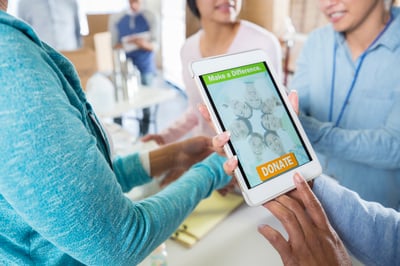September 10, 2019
 by Gerard Tonti / September 10, 2019
by Gerard Tonti / September 10, 2019

Getting a donor is half the battle; the other half is keeping them.
Keeping your donors engaged year after year is a constant challenge. Donor retention is the key to long-term success. It's more than just securing a one-time donation; it's about fostering meaningful relationships that inspire continued giving.
Efforts in donor retention focus on stewarding donors, building loyalty through effective communication, acknowledging donation impact, and developing long-term relationships with supporters. A donor management software is often used by nonprofits to manage donor information, track fundraising events, and maintain relationships with donors.
Donor retention refers to the ability of a nonprofit organization to keep its donors contributing over time. It acts as a measure of how effectively an organization maintains its donor base. Donor retention is typically expressed as a percentage representing the number of individuals or entities that continue to donate over a specific period, usually year-over-year.
High donor retention indicates that an organization is maintaining a solid relationship with its donors. Low donor retention might hint at underlying issues such as donor dissatisfaction, or a disconnect between the nonprofits mission and donor values.
Retaining donors is often more cost-effective and sustainable for nonprofits than acquiring new ones, as the cost of recruitment and the uncertainty involved in first-time donor commitments can be higher. Here are a few donor retention strategies that you can implement to create long lasting donor relationships.
Let's dig deeper into each of these donor retention strategies and learn how we can implement them.
As you build up your donors, you’ll want to have a database that stores all their information in one central location. This makes accessing information quickly a breeze. Donor management software is a central hub for personalized information about each and every one of your donors. Nonprofits of all sizes can benefit from using this type of software.
While most nonprofits only include the information donors submit in donation submissions, some organizations include each donation amount. Even though this is a great first step, there’s so much more you can do.
Some additional important donor management software features to look for are:
When all of your donor data is in one central location, it’s easier to pull this information when planning your fundraising strategies. Your software should offer several tools to create a positive, customized donor experience. By using these tools, you can even expand your online fundraising plan. Discover what tools to look for in your salesforce donor management software.
An effective donation software can improve donor retention by helping you coordinate outreach. Nonprofit CRM software helps your nonprofit raise more money with less effort, freeing up time and money that can be used on the fundraising campaign itself.
By making the most of your donation tools, you’re one step ahead of the competition.
Not only is using donation software a great way to revamp your fundraising approach, but you can also improve the donor experience with appealing campaign pages, easy-to-use forms, and much more.
Corporate giving programs are a mutually beneficial opportunity for nonprofits and corporations. These programs are an easy way to boost your organization’s funds, double your volunteers’ contributions, and engage your supporters.
There are 4 main corporate giving programs you should be aware of:
Corporate giving programs are often underutilized due to lack of awareness by donors, volunteers, and even nonprofit professionals. Educating your supporters about these overlooked opportunities maximizes the return of their efforts. Making use of such programs multiplies their contribution and makes them feel more vital to the success of your organization.
These programs don’t require much more effort from supporters aside from brief paperwork. When supporters know their contribution is valued and significant, you re-engage them and form stronger, more loyal, relationships – keeping them for years to come.
Prospect research is the process of learning more about your donors from publicly available data and is essential for identifying potential high-impact donors.
It gives you additional insight as to who your donors are and what motivates them to give. No matter what your goals are, any nonprofit can benefit from donor prospect research software by saving time and resources and boosting fundraising efforts.
Prospect research tools can measure a donor’s capacity to give, as well as how likely they are to give. These tools go through your donors’ personal backgrounds, measuring individuals’ giving history, wealth indicators, and philanthropic factors.
So, how do you pick the right prospect research software? As with any software, it’s based on your nonprofit’s needs.
These factors indicate affinity capacity, philanthropic interests, and professional stability. When searching for the right prospect research technology, make sure to find one that’s capable of doing a social profile search on current and potential donors.
The more data you gather, the more you’ll know about your donors, including their preferences, affiliations, and so forth. When your donors feel as though you’ve taken the time to get to know them, their loyalty increases, helping you to gain and keep their support.
A golden donation is that sought-after second donation.
The process for securing a second donation is fairly straightforward and may align with some of your nonprofit’s existing practices:
Donor retention rates can significantly vary across different sectors and types of nonprofits. A good retention rate may also vary depending on factors such as size of the organization or resources. A simple formula to calculate the donor retention rate is:
Donor Retention Rate = (Number of Retained Donors ÷ Number of Donors at Start of Time Frame) × 100
Key points to consider:
Apart from the donor retention rate, calculating donor lifetime value (LTV) and donor attrition rate helps you get an overall picture of your retention efforts.
LTV gives you an approximate value of how much one donor may contribute to your organization through their lifetime. A simple formula to calculate LTV is:
Average annual donation amount x Number of years with your nonprofit = Donor LTV
The metric can be used to prioritize donors you may want to focus on.
Donor attrition rate, often referred to as donor churn rate, is the percentage of donors who do not donate again over a specific period of time. Here’s a simple formula to calculate the same.
Attrition Rate (%) = (Number of Lost Donors / Number of Donors last year ) x 100
The benchmark for a good attrition rate also depends on industry averages, so non-profits often compare their rates against similar organizations to evaluate their own performance.
Donor retention is of significant importance to nonprofit organizations for several compelling reasons:
Remember to choose the right donor management software, use donation tools, leverage corporate giving opportunities, do smart prospect research, and focus on getting recurring donations. Retaining donors is something many nonprofits fail to do properly. Put these strategies to use and you’ll be on your way to keep their support for years to come.
Learn more about donor acquisition to help ensure that you meet your goals.
This article was originally published in 2019. It has been updated with new information.
Gerard Tonti is the Senior Creative Developer at Salsa Labs, a fundraising software company for growth-focused nonprofits. Gerard's marketing focus on content creation, conversion optimization, and modern marketing technology helps him coach nonprofit development teams on digital fundraising best practices.
As a nonprofit professional, you know the value of developing genuine relationships with your...
 by Steven Shattuck
by Steven Shattuck
As a nonprofit professional, you've likely researched effective donor management strategies...
 by John Killoran
by John Killoran
Your nonprofit needs a healthy mix of new and old donors to ensure there’s enough fundraising...
 by Gerard Tonti
by Gerard Tonti
As a nonprofit professional, you know the value of developing genuine relationships with your...
 by Steven Shattuck
by Steven Shattuck
As a nonprofit professional, you've likely researched effective donor management strategies...
 by John Killoran
by John Killoran


